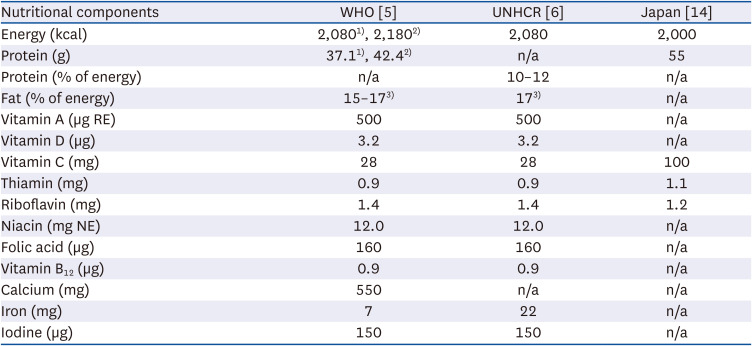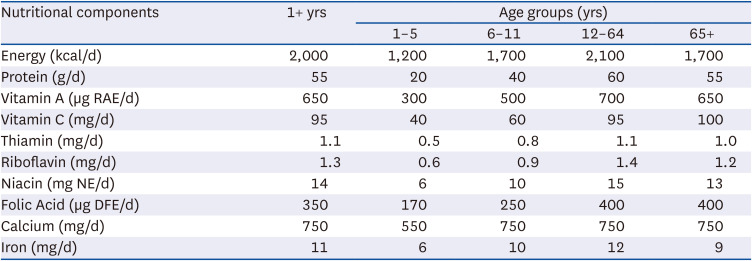1. International Federation of Red Cross and Red Crescent Societies. World Disasters Report 2020 [Internet]. Geneva: International Federation of Red Cross and Red Crescent Societies;2020. cited 2021 May 2. Available from:
https://media.ifrc.org/ifrc/world-disaster-report-2020.
2. Okuda K, Kuragano T, Nakano H, Kitao A, Kitao N. Refugee camp meals at the Great Kobe Earthquake: the refugees responses and the problems. J Integr Stud Diet Habits. 1996; 7:35–41.
3. Nakano H, Okuda K, Kuragano T, Kitao A, Kitao N. Refugee camp meals at the Great Kobe Earthquake: how did the refugees respond to the rationed meals? J Integr Stud Diet Habits. 1996; 7:29–34.
4. Noji EK. Public health issues in disasters. Crit Care Med. 2005; 33:S29–S33. PMID:
15640676.

5. World Health Organization. United Nations High Commissioner for Refugees. International Federation of Red Cross. World Food Programme. The Management of Nutrition in Major Emergencies [Internet]. Geneva: World Health Organization;2000. cited 2021 May 2. Available from:
https://www.who.int/publications/i/item/9241545208.
6. Weise Prinzo Z, de Benoist B. Meeting the challenges of micronutrient deficiencies in emergency-affected populations. Proc Nutr Soc. 2002; 61:251–257. PMID:
12133207.

7. United Nations High Commissioner for Refugees. United Nations Children’s Fund; World Food Programme. World Health Organization. Food and Nutrition Needs in Emergencies [Internet]. Geneva: World Health Organization;2002. cited 2021 May 2. Available from:
https://www.unhcr.org/uk/45fa745b2.pdf.
8. Food and Nutrition Service (FNS), USDA. Nutrition standards in the National School Lunch and School Breakfast Programs. Final rule. Fed Regist. 2012; 77:4088–4167. PMID:
22359796.
9. Storcksdieck Genannt Bonsmann S, Kardakis T, Wollgast J, Nelson M, Caldeira S. Mapping of National School Food Policies across the EU28 plus Norway and Switzerland. Luxembourg: Publications Office of the European Union;2014. p. 30–31. p. 34–35.
10. Enforcement Rules of School Meals Act. Nutritional Standards for the School Lunch Program. Sejong: Ministry of Education of Korea;2021.
11. School-Meals Act. School Meals Performance Standards. Tokyo: Ministry of Education, Culture, Sports, Science and Technology of Japan;2021.
13. Ministry of Agriculture, Food, Fisheries, Rural Affairs and Regional Planning. 2011 Relating to the Nutritional Quality of Meals Served as Part of School Catering [Internet]. Paris: Ministry of Agriculture, Food, Fisheries, Rural Affairs and Regional Planning;2011. cited 2021 July 17. Available from:
https://www.legifrance.gouv.fr/loda/id/JORFTEXT000024614763.
16. Ministry of the Interior and Safety. 2019 Annual Natural Disaster Report [Internet]. Sejong: Ministry of the Interior and Safety;2020. cited 2021 October 13. Available from:
https://www.mois.go.kr.
17. Ministry of the Interior and Safety. Guidelines for Operating Temporary Housing Facilities for Victims. Sejong: Ministry of the Interior and Safety;2018.
18. Ministry of the Interior and Safety. Enforcement Decree of the Disaster Relief Act. Sejong: Ministry of the Interior and Safety;2020.
19. Kim M, Kim D, Yoon J. Selection of target nutrients for the nutritional standards of school lunches in Korea. Nutrients. 2019; 11:2578. PMID:
31731491.
20. Ministry of Health and Welfare, Korea Disease Control and Prevention Agency. Korea Health Statistics 2019: Korea National Health and Nutrition Examination Survey (KNHANES VIII-1) [Internet]. Cheongju: Ministry of Health and Welfare, Korea Disease Control and Prevention Agency;2020. cited 2021 May 2. Available from:
https://knhanes.kdca.go.kr/knhanes/sub04/sub04_04_01.do.
21. Ministry of Health and Welfare, Korea Centers for Disease Control and Prevention. Guidelines for the Use of Raw Data of the 8th (2019). Korean National Health and Nutrition Examination Survey. Cheongju: Ministry of Health and Welfare, Korea Centers for Disease Control and Prevention;2021.
22. Ministry of Health and Welfare. Korean Nutrition Society. Dietary Reference Intakes for Koreans 2020. Seoul: Korean Nutrition Society;2020. p. xix. p. xxiv. p. xxv.
23. Ministry of Health and Welfare. Korean Nutrition Society. Dietary Reference Intakes for Koreans 2020: Energy and Macronutrients. Seoul: Korean Nutrition Society;2020. p. 13–14. p. 22–23. p. 121–126. p. 169–174. p. 211
24. Brooks GA, Butte NF, Rand WM, Flatt JP, Caballero B. Chronicle of the Institute of Medicine physical activity recommendation: how a physical activity recommendation came to be among dietary recommendations. Am J Clin Nutr. 2004; 79:921S–30S. PMID:
15113740.
26. Murakami H, Yoshimura E, Ishikawa-Takata K, Hasegawa Y, Kubota T, Tsuboyama-Kasaoka N, Nishi N, Yokoyama Y, Yaegashi Y, Sakata K, et al. Validity and reproducibility of a physical activity questionnaire used for health surveying among victims of the Great East Japan Earthquake. Nihon Koshu Eisei Zasshi. 2013; 60:222–230. PMID:
23909189.
27. Moriyama N, Urabe Y, Onoda S, Maeda N, Oikawa T. Effect of residence in temporary housing after the Great East Japan Earthquake on the physical activity and quality of life of older survivors. Disaster Med Public Health Prep. 2017; 11:701–710. PMID:
28625213.

28. Statistics Korea. 2019 Population and Housing Census. Daejeon: Statistics Korea;2020.
29. Ministry of Health and Welfare. Korean Nutrition Society. Dietary Reference Intakes for Koreans 2020: Vitamins. Seoul: Korean Nutrition Society;2020. p. 9–15. p. 19p. 24p. 140–144. p. 166–170. p. 188–193. p. 212–217. p. 266–268.
30. Ministry of Health and Welfare. Korean Nutrition Society. Dietary Reference Intakes for Koreans 2020: Minerals. Seoul: Korean Nutrition Society;2020. p. 7–15. p. 75–77. p. 80–81. p. 99–101. p. 142–151. .
31. Morishita T, Kubo K. Survey of the diets of persons in refuge centers after the Great Hanshin-Awaji Earthquake and the effect of the latter supplements: Higashinada-ku, Kobe. J Cookery Sci Jpn. 1997; 30:347–354.
32. Magkos F, Arvaniti F, Piperkou I, Katsigaraki S, Stamatelopoulos K, Sitara M, Zampelas A. Identifying nutritionally vulnerable groups in case of emergencies: experience from the Athens 1999 earthquake. Int J Food Sci Nutr. 2004; 55:527–536. PMID:
16019296.

33. Dong C, Ge P, Ren X, Zhao X, Fan H, Yin SA, Weiderpass E. Evaluating the micronutrient status of women of child-bearing age living in the rural disaster areas one year after Wenchuan Earthquake. Asia Pac J Clin Nutr. 2014; 23:671–677. PMID:
25516326.
34. Dong C, Ge P, Ren X, Zhao X, Wang J, Fan H, Yin SA. The micronutrient status of children aged 24-60 months living in rural disaster areas one year after the Wenchuan Earthquake. PLoS One. 2014; 9:e88444. PMID:
24533089.

35. Yuasa M, Sawamura H, Ebara S, Matsui A, Watanabe T. Securing vitamin nutrition in the event of a disaster. Vitamins. 2011; 85:389–399.
36. Asano K, Yang H, Lee Y, Kim M, Yoon J. Designing optimized food intake patterns for Korean adults using linear programming (II): adjustment of the optimized food intake pattern by establishing stepwise intake goals of sodium. J Nutr Health. 2019; 52:342–353.
37. Drewnowski A, Rehm CD, Maillot M, Mendoza A, Monsivais P. The feasibility of meeting the WHO guidelines for sodium and potassium: a cross-national comparison study. BMJ Open. 2015; 5:e006625.

38. Heaney RP. Sodium: how and how not to set a nutrient intake recommendation. Am J Hypertens. 2013; 26:1194–1197. PMID:
24042548.
39. Tsuboyama-Kasaoka N, Purba MB. Nutrition and earthquakes: experience and recommendations. Asia Pac J Clin Nutr. 2014; 23:505–513. PMID:
25516307.
41. Ministry of Health, Labour and Welfare. Implementation of Appropriate Nutritional Management Related to Meal Provision at Evacuation Shelters [Internet]. Tokyo: Ministry of Health, Labour and Welfare;2016. cited 2021 May 2. Available from:
https://www.mhlw.go.jp/content/000622116.pdf.
42. Food and Agriculture Organization of the United Nations. World Health Organization. Requirements of Vitamin A, Iron, Folate, and Vitamin B12: Report of a Joint FAO/WHO Expert Consultation. Rome: Food and Agriculture Organization of the United Nations;1988. p. 17p. 30–31.
43. Institute of Medicine. Dietary Reference Intakes for Vitamin A, Vitamin K, Arsenic, Boron, Chromium, Copper, Iodine, Iron, Manganese, Molybdenum, Nickel, Silicon, Vanadium, and Zinc. Washington, D.C.: National Academies Press;2001. p. 2p. 30–31.
44. Passmore R, Nicol BM, Rao MN, Beaton GH, DeMaeyer EM. Handbook on human nutritional requirements. Monogr Ser World Health Organ. 1974; 1–66.
45. World Health Organization. Food and Agriculture Organization of the United Nations. Requirements of Vitamin A, Thiamine, Riboflavine and Niacin: Report of a Joint FAO/WHO expert group, Rome, Italy, 6-17 September 1965 [Internet]. Geneva: World Health Organization;1967. cited 2021 May 2. Available from:
https://apps.who.int/iris/handle/10665/40656.
46. Hallberg L, Hulthén L. Prediction of dietary iron absorption: an algorithm for calculating absorption and bioavailability of dietary iron. Am J Clin Nutr. 2000; 71:1147–1160. PMID:
10799377.
47. DeMaeyer EM, Dallman P, Gurney JM, Hallberg L, Sood SK, Srikantia SG. World Health Organization. Preventing and Controlling Iron Deficiency Anaemia through Primary Health Care: A Guide for Health Administrators and Programme Managers [Internet]. Geneva: World Health Organization;1989. cited 2021 May 2. Available from:
https://apps.who.int/iris/handle/10665/39849.













 PDF
PDF Citation
Citation Print
Print





 XML Download
XML Download